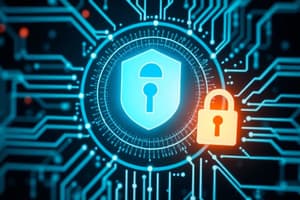Podcast
Questions and Answers
What is the primary purpose of encryption in cybersecurity?
What is the primary purpose of encryption in cybersecurity?
- To enhance network speed
- To secure data from unauthorized access (correct)
- To compile and store data
- To update software automatically
What type of cyber threat involves overwhelming a target with excessive traffic?
What type of cyber threat involves overwhelming a target with excessive traffic?
- SQL Injection
- Malware
- Phishing
- DDoS Attack (correct)
Which cybersecurity framework provides a set of best practices for managing risks?
Which cybersecurity framework provides a set of best practices for managing risks?
- NIST Cybersecurity Framework (correct)
- HIPAA
- ISO/IEC 27001
- GDPR
What is a common objective of User Education in cybersecurity practices?
What is a common objective of User Education in cybersecurity practices?
Which of the following is NOT a type of cybersecurity threat?
Which of the following is NOT a type of cybersecurity threat?
What aspect of incident response is focused on limiting damage after a security breach?
What aspect of incident response is focused on limiting damage after a security breach?
Which regulation focuses on protecting sensitive patient information in healthcare?
Which regulation focuses on protecting sensitive patient information in healthcare?
What is a critical element of Zero Trust Security?
What is a critical element of Zero Trust Security?
Flashcards are hidden until you start studying
Study Notes
Overview of Cybersecurity
- Definition: The practice of protecting computers, servers, mobile devices, electronic systems, networks, and data from malicious attacks.
- Importance: Essential for protecting sensitive information, ensuring privacy, and maintaining business operations.
Types of Cyber Threats
- Malware: Malicious software including viruses, worms, and ransomware.
- Phishing: Fraudulent attempts to obtain sensitive information by disguising as trustworthy entities.
- DDoS Attacks: Distributed Denial of Service attacks overwhelm a target with traffic, causing service disruption.
- Man-in-the-Middle Attacks: Interception of communication between two parties without their knowledge.
- SQL Injection: Inserting malicious SQL queries into a database to manipulate data.
Key Cybersecurity Practices
- Firewalls: Hardware or software that blocks unauthorized access to networks.
- Antivirus Software: Programs designed to detect and eliminate malware.
- Encryption: Securing data by converting it into a code to prevent unauthorized access.
- Regular Updates: Keeping software and systems updated to protect against vulnerabilities.
- User Education: Training employees on recognizing cyber threats and safe online practices.
Cybersecurity Frameworks
- NIST Cybersecurity Framework: A policy framework of a set of standards, guidelines, and best practices to manage cybersecurity risks.
- ISO/IEC 27001: International standard for information security management systems (ISMS).
Incident Response
- Preparation: Developing an incident response plan and training staff.
- Detection and Analysis: Identifying and analyzing security incidents promptly.
- Containment, Eradication, and Recovery: Limiting damage and restoring systems to normal operations.
- Post-Incident Review: Analyzing what happened and how to improve future response.
Emerging Trends
- AI in Cybersecurity: Utilizing artificial intelligence for threat detection and response.
- Zero Trust Security: Security model requiring strict identity verification for every user and device.
- IoT Security: Focus on securing Internet of Things devices, which can be vulnerable to attacks.
Legal and Regulatory Considerations
- GDPR: General Data Protection Regulation impacting how organizations handle personal data.
- HIPAA: Health Insurance Portability and Accountability Act, protecting sensitive patient information.
- PCI-DSS: Payment Card Industry Data Security Standard for organizations that handle credit card information.
Overview of Cybersecurity
- Cybersecurity involves protecting computers, servers, mobile devices, networks, and sensitive data from malicious attacks.
- It is crucial for safeguarding sensitive information, ensuring privacy, and maintaining continuous business operations.
Types of Cyber Threats
- Malware: Encompasses various malicious software types, such as viruses, worms, and ransomware, which can disrupt or damage systems.
- Phishing: Involves deceptive practices to obtain sensitive data by pretending to be legitimate entities, often via email.
- DDoS Attacks: These attacks overwhelm a target with excessive traffic, rendering services unavailable to users.
- Man-in-the-Middle Attacks: This tactic involves intercepting communications between parties to secretly monitor or manipulate data.
- SQL Injection: Attackers insert malicious SQL statements into databases, allowing unauthorized manipulation of data.
Key Cybersecurity Practices
- Firewalls: Serve as barriers that safeguard networks from unauthorized access and threats.
- Antivirus Software: Designed to identify and eliminate malware threats on devices and networks.
- Encryption: The process of converting data into a coded format to protect it from unauthorized access.
- Regular Updates: Keeping software and systems current is vital for defending against newly discovered vulnerabilities.
- User Education: Training for staff on how to identify cyber threats and practicing safe online behaviors is essential.
Cybersecurity Frameworks
- NIST Cybersecurity Framework: Offers a comprehensive set of standards and guidelines for managing cybersecurity risks.
- ISO/IEC 27001: An international standard focused on establishing, implementing, and managing information security management systems (ISMS).
Incident Response
- Preparation: Involves creating a detailed incident response plan and conducting staff training to ensure readiness.
- Detection and Analysis: Timely identification and assessment of security incidents is crucial for effective response.
- Containment, Eradication, and Recovery: Steps taken to limit damage from incidents and restore systems to normal function.
- Post-Incident Review: Conducting analyses of incidents to understand failures and improve future responses.
Emerging Trends
- AI in Cybersecurity: The integration of artificial intelligence technologies enhances threat detection and response capabilities.
- Zero Trust Security: A security paradigm mandating verification for every user and device attempting to access resources.
- IoT Security: Addressing the vulnerabilities of Internet of Things devices that are increasingly targeted by cyber attacks.
Legal and Regulatory Considerations
- GDPR: This regulation governs the handling and processing of personal data, imposing strict guidelines on organizations.
- HIPAA: Establishes standards for protecting sensitive patient health information in the healthcare sector.
- PCI-DSS: A set of security standards aimed at ensuring that organizations handle credit card information securely.
Studying That Suits You
Use AI to generate personalized quizzes and flashcards to suit your learning preferences.




